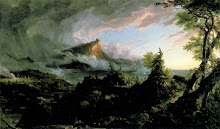Summary:
Hegel traces the progression of man's ability to represent his ideas concerning the divine in three stages: symbolic art, Classical art, leading to Romantic art. Romantic art, Hegel argues, shows the "union of matter and form" because man now has the "divine within" (III p.4), making art a reconcilliation between man (internal) and god (external). To do this, man no longer needs to represent symbols of the absolute, but now may represent the external form of the absolute: nature. Painting, music, and poetry are the best modes to represent this unity.
Assumed Values:
Like Kant, symbols combine mind and sensory info.
Absolute (sublime) = formless
Greek represents the former ideal
Christian (European) purer artform than others (Asian)
Art = Unity of material (external) and ideas (internal)
New Values:
Myths are religion's equals (Christianity) though an earlier stage of progress.
Man's ideas have progressed; thus, art progresses.
Sculpture no longer the ideal artform.
Divine (Absolute) within
Romantic ideals supreme.
Questions:
How did the divine get "within"? I missed this step.
In what ways do Hegel and Kant overlap?
Links:
If I did understand Hegel, I'm not sure I could have without my art history background. I could really see his ideas present in the paintings of the Hudson River School and in the poems like "Ode to the West Wind" (Shelley). The landscapes where man is dwarfed by nature, but still a part of it, reminded me of this "reconciliation." When Shelley asks the wind to "make [him] thy lyre" and "Be thou me," this marks the change from (but also reminds me of) Homer's "Sing in me, Muse." Both claim inspiration from something outside of themselves that they, in turn, internalize. However, Homer is paying respects to the divine rather than to the forces of nature, and Homer isn't claiming to become "one" with the divine.
Subscribe to:
Post Comments (Atom)
.jpg)
.jpg)
.jpg)
No comments:
Post a Comment